HEK Net Works
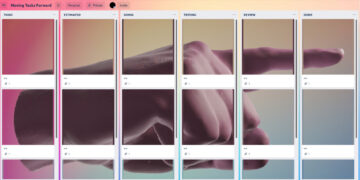
In March 2020, HEK launched the HEK Net Works project series, inviting artists to create net-based projects specifically for HEK's digital channels. They are to occupy the digital space in a way that corresponds to their artistic practice.
The series began on a weekly basis during the Covid 19-caused initial lockdown in March 2020 and has continued with a monthly feature since the summer of 2020.
The pandemic-related closure of museums worldwide weakened the already precarious situation of artists who lack a regular income. With this initiative, HEK supported the work of artists who create network-based projects. In the meantime, the series has established itself as an integral part of HeK's online activities.
Markus Aebersold & Chris Handberg
“…the more there is”
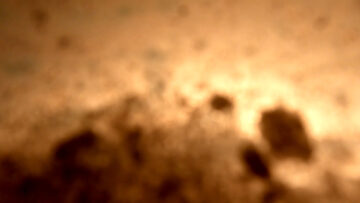
Markus Aebersold and Chris Handberg have created an audiovisual composition as an exploration of aural and imaginary spaces. Influenced by conditions of isolation - the text was in fact written during the artists' lockdown period in Iceland - the work invites the viewer to immerse themselves in a guided meditative experience. The artists ask whether the imagined experiences are more or less real than the lived ones, and by analogy they ask whether virtual, online experiences are less or as incisive as real-world experiences. To what extent can imagined spaces and objects convey meanings if they are never communicated or shared with other individuals?
The work is accessible on HEK's Vimeo, the artists encourage viewers to use headphones, and to play the video in full screen.
In their artistic practice Markus Aebersold and Chris Handberg investigate the relationships between the technological and the spiritual human being. Topics such as digital anxiety, faith in science, hope and reality are pervasive to the problems they explore. They work with the bridges that our senses make between virtual, physical and mental space and our ability to believe in all three simultaneously.
The duo's artistic dialogue produces works, which are a materialisation of shared memories of a non-existent technological mythology. The works are at the same time monuments, representations, as well as materialisations of these myths. Markus Aebersold (*1988 CH) and Chris Handberg (*1989 DK) live and work in Basel, where they graduated together from the Institute of Art HGK FHNW in 2017. In 2020 they were nominated for the Swiss Emerging Artist Prize and in 2021 for the Basel Media Art Prize.
In October and November, HEK Net Works will take the form of a 10-part NFT-manifesto by UBERMORGEN, the crypto manifesto tokens #1 - #10.
UBERMORGEN
crypto manifesto tokens #1 - #10
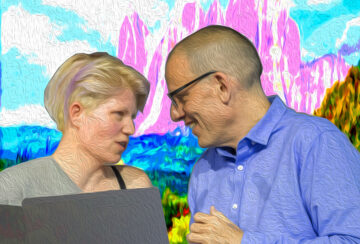
In October and November, HEK Net Works will take the form of a 10-part NFT-manifesto by UBERMORGEN, the crypto manifesto tokens #1 - #10.
Neither political nor ideological - but definitely actionist, investigative and sometimes provocative – that's how the internationally active artist duo UBERMORGEN present themselves. The work of lisvlx and Luzius Bernhard is based on extensive research and usually results in net-based projects, code and deliberately disruptive interventions in various systems – be it mass media, technologies or even the legal order.
UBERMORGEN first appeared in international media when they launched their famous political discourse intervention, Vote-Auction. The Vote-Auction online platform was created during the 2000 US presidential election and claimed to allow Americans to sell their vote online. Other works by UBERMORGEN are no less provocative and critical. GWEI – Google will Eat itself aims to deconstruct Google as a global player by developing a system of economic auto-cannibalism in which money generated through use of advertisement space is automatically invested in Google shares and re-distributed to a common ownership trust.
The duo have also tried their hand in the medium of NFTs, an early iteration being The D1cks – two of which belong to the HEK collection. In this NFT series UBERMORGEN critically poke fun at the growing public desire for designer PFPs (Profile Pictures) by creating a collection of pixelised penis PFPs. In their newest NFT collection UBERMORGEN once again take an ironic approach to the provocative hype of the international crypto market with their crypto manifesto token #1-#10 series. Described as „haute couture“ NFTs, crypto manifesto tokens, which are based on the duos new 10 part manifesto, will be launched every three days in October as part of HEK Net Works and minted on the fx(hash) platform.
Artist Statement:
UBERMORGEN
crypto manifesto token #01-#10
chain my heart
The últra contemporary! minted declaration of intentions, motives, & views of UBERMORGEN caught in 16k, merged in 2018, wounded amour-propre lab-grown meat of post crypto 1995.
On methodologies, politics of existence, legal & structural models, beyond media, NFT haute couture, new chain structured media & web(3) reality & ¿Gesamtkunstwerk? Biopunk & financial curiosity in l'origine du pixel one-of-one polarising dark research & radical AI, pink binary primitivism & conceptualism.
What does it even mean?
Entertainment is our success.
Bio:
UBERMORGEN (‘the day after tomorrow’, CH/AT/US, *1995) is an artist duo with a steady worldwide presence, a synthesis of autistic actionist lizvlx (Liz Katlein) & pragmatic visionary Luzius Bernhard (formerly Hans Bernhard). They are net.art pioneers, ‘Media Hackers’ widely recognized for their Online Actionism, Haute Couture NFTs & Websites, Polarising Social Experiments, Radical Research, Dark AI, Binary Primitivism & Conceptualism; Artfacts calls their work ‘Ultra Contemporary’. CNN called them 'Maverick Austrian Business People' during their Vote-Auction project, reaching 500 million worldwide & challenging the FBI, CIA, & NSA (US presidential election 2000). A series of conceptual hacks (EKMRZ Trilogy, 2005-08) shook the foundations of the dominating e-commerce giants: ‘Google Will Eat Itself’, ‘Amazon Noir’, & ‘The Sound of eBay’. In 2021, ‘The Next Biennial Should be Curated by a Machine’ used AI-TikTikPop to catapult visitors into 64 twisted parallel universes. Today ‘UNINVITED’ AI Horror Film & Crypto Art collide to create deeply nostalgic synthetic organisms and ‘The D1cks’, hand-pixelated 1 of 1 Haute Couture NFTs reveal ‘L‘Origine du pixel’. UBERMORGEN's work has been exhibited throughout the world, for example in New York, Sydney, Shanghai, Singapore and Tokyo, often in digital spaces.
WEB http://ubermorgen.com
INSTAGRAM @ubermorgen_77
TWITTER @UBERMORGEN_COM
EPK: https://www.ubermorgen.com/UM/UBERMORGEN_PORTFOLIO_EPK_8MB.pdf
HEK Net Works: DISNOVATION.ORG «LIFE SUPPORT SYSTEM»
«LIFE SUPPORT SYSTEM»
The HEK Net Works series features a net-based project produced specifically for our online spaces, website and social networks. This month we present LIFE SUPPORT SYSTEM by DISNOVATION.ORG.
Our general view of the world that surrounds us as humans is determined by an economic understanding of our environment. As far as natural resources are concerned, we calculate our need for consumption and evaluate them according to their economic benefit to us. The importance of the work of the biosphere and all the ecosystems within it - that enable the growth of life - is mostly absent from dominant economic understanding. For this month's edition of HEK Net Works, DISNOVATION.ORG livestream their indoor farm LIFE SUPPORT SYSTEM on the HEK website, which allows us to recognize the dimensions of the work of the biosphere.
DISNOVATION.ORG visualise our relationship with our natural environment by artificially growing wheat on a precisely measured area of one square metre. All necessary inputs such as hydration, light, heat and nutrients are systematically calculated and displayed to the public. The LIFE SUPPORT SYSTEM with an area of one square metre has the capacity to generate every four months the amount of calories an adult human needs in one day. To supply a human being with sufficient nutrients for a year would require 100 units running simultaneously. Considering that wheat has accounted for most of the caloric intake of humans in Europe throughout history, this project highlights the immense dimensions of the resources needed to meet human nutritional needs with the support of the natural biosphere, which we normally take for granted and expect to be able to use for free. Without the work of the biosphere - which is to say without sunlight, rain, wind and many other factors - the economic cost of artificially grown wheat is €200-400 per kilogram. This figure seems impressive when compared to the 30 cents per kilogram we currently pay for conventionally grown wheat. Exploiting the lands and requiring radical changes, conventional agriculture consistently interferes with the natural biosphere.
However, as we can see in the indoor-farm-experiment, hydroponic systems are not yet an alternative for supplying humanity with staple food due to the high material and energy costs.
LIFE SUPPORT SYSTEM makes us aware of the dimensions of the work we trust our ecosystems to do for free. The underestimated and constantly overextended work we leave to the natural biosphere is thus made visible. Our economic system would be worthless without the primary value that ecosystems provide, which should help us to re-examine the value we attribute to our natural surroundings.
DISNOVATION.ORG is a research collective set up in Paris in 2012, whose core members include Maria Roszkowska (PL), Nicolas Maigret (FR), and Baruch Gottlieb (CA). They work at the interface between co@ntemporary art, research, and hacking, and compose tailor-made teams for each investigation together with academics, activists, engineers, and designers. More specifically their recent artistic provocations seek to empower Post Growth imaginaries and practices by challenging the widespread faith that ‘economic growth’ and ‘technological fixes’ will solve the ecosystemic disruptions they produced in the first place. They recently co-edited A Bestiary of the Anthropocene with Nicolas Nova, an atlas of anthropic hybrid creatures, and The Pirate Book, an anthology on media piracy. DISNOVATION.ORG’s works have been exhibited, performed, published, and reviewed worldwide, for example at the Centre Pompidou (Paris), transmediale (Berlin), the Museum of Art and Design (New York) and China Museum of Digital Arts (Beijing).
Eva & Franco Mattes
Panorama Cat, 01.08.2022
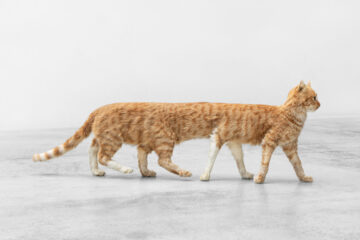
The HEK Net Works series features a net-based project produced specifically for our online spaces, website and social networks. This month we present Panorama Cat by Eva & Franco Mattes.
The popularity of cats in internet pop culture has culminated in the manifestation of the meme subgenre LOLcat. In response to this phenomenon, Eva & Franco Mattes have created taxidermic sculptures such as Half Cat (2020) or Ceiling Cat (2016) which in their absurdity are a metaphor for the ever-circulating, interconnected and often manipulated image that has gone viral. By playing with the sensation and peculiarity of the popular meme subject, bringing it into real space, the cat is removed from its context. The artist duo Eva & Franco Mattes have focused their work around networked imagery since the mid 90s. Through their practice, the artists challenge the audience to consider their role as recipients and contributors of online content whilst holding up a mirror to behavioural patterns of a networked society. For this month’s edition of the HEK Net Works series and in continuation of the cat epos, Eva & Franco Mattes present a social media-based version of the LOLcat meme.
Artists' statement:
Panorama Cat is a sculpture Based on the “panorama fails” internet phenomenon. Panoramic photography is a technique of photography, using specialized software, that captures images with horizontally elongated fields of view. Creating panoramas used to be a lot of hard work and only tech-savvy photographers knew how to do it, manually stitching photos on the computer. Things have changed in recent years with the introduction of the panorama photo feature in phones, which allows everyone to take a panorama photo, since 'the phone can do it all for you.' With the popularization of the feature, came a flood of mistakes: 'Panorama fails that are so bad they're good.'
Eva & Franco Mattes (IT) are an artist duo based in New York. They are considered amongst the pioneers of web based art. Their work spans from videos to installations and websites. Oftentimes with a humorous touch, Eva & Franco Mattes’ work concerns itself with the social, ethical and political impact of the networked condition on society. They have internationally exhibited and are represented in the collections of the SFMOMA (San Francisco), Whitney Museum of American Art (New York), Fotomuseum Winterthur, X Museum (Karlsruhe) and the Walker Art Center (Minneapolis).
Eva Papamargariti
Untether (Exhaustion/Excess), 01.06.2022

For the HEK Net Works series, the artist presented a collection of short videos on our social networks, featuring avatars who engaged the audience with enigmatic behaviour and monologues.
Using 3D modelling and animation software, Eva Papamargariti creates fantastic, sometimes uncanny landscapes and creatures that often result from the combination of incongruous elements. The video series complemented Papamargariti's intervention at the Liste Art Fair in Basel, where HEK was invited as a guest institution.
Artist’s statement:
«Untether (Exhaustion/Excess) is a short series of videos that approach a plethora of emerging bodies, at times as a single collective body or as unique entities. These peculiar avatars that resemble something between video-game characters and mythological creatures, make gestures, moving their bodies in lethargic or ecstatic ways. They engage in unexpected or banal motions and expressions whilst synchronizing, abandoning or uniting with each other repeatedly. Through this motion they create an uncanny choreography in which they attempt to identify themselves as individuals. At times these avatars pose questions and reveal their inner thoughts - it is unclear if they are talking to themselves, talking to each other or if they are trying to communicate with the viewers or other critters/avatars.»
HEK Net Works presented Eva Papamargariti's work Untether (Exhaustion/Excess) from 01.06.2022 to 30.06.2022.
Eva Papamargariti is an artist based between London and Athens. She has exhibited her work in institutions, museums, and festivals such as the New Museum (New York), Whitney Museum (New York), Tate Britain (London), MAAT Museum (Lisbon), Museum of Moving Image (New York), MoMA PS1 (New York), Montreal Museum of Contemporary Art (Montreal), Athens Biennale (Athens), Thessaloniki Biennale (Thessaloniki) and Transmediale Festival (Berlin).
Studer / van den Berg
fungible giveaway, 01.05.2022

For this months‘ HEK Net Work series, Studer / van den Berg asked us to be more fungi-like.
The Republic of Fungi, an ongoing project by artist duo Studer / van den Berg, is gifting us with one-of-a-kind fungi. Each unique, in real time generated, 3D digital fungible giveaway comes with a numbered HTML certificate when downloaded, allowing it to be viewed on a web browser. Hosts can observe their fungus rotate, be mesmerised by its tireless spin and share or exchange their certificates to build their own networks. In an era of hyper-commercialised networks, the free and exchange-ready fungible giveaway is a commentary on the ongoing discourse on non-fungible tokens (NFTs) and an homage to the culture of fungi. As a metaphor for the symbiotic but equally parasitic co-existence within a network, able to produce substances in exchange with the environment, the mushroom is considered as a role model for a post-human, interconnected society.
Your fungible token can be downloaded via the following link: http://studervandenberg.ch/Rep...
For a real-time generated 3D view of the mushroom, navigate to your download folder and find the gift certificate named «giveawayXXX.html». Open the file in your web browser (Google Chrome or Firefox) and hit the «mushroom» button.
HEK Net Works presented Studer / van den Berg's work fungible giveaway from 01.05.2022 to 31.05.2022.
Studer / van den Berg is a Swiss artist duo that has been shaping Swiss media art for over 30 years. Monica Studer from Zurich and Christoph van den Berg from Basel are considered pioneers of Swiss computer-based art, whilst simultaneously having an international presence with their distinctive practice that explores the relationship between physical and digital space. The artist’s works are characterised by subtle fictional narratives placed in hybrid settings. Through the use of current technologies, Studer / van den Berg question the development of new media and their influence on the physical world.
Myriam Thyes
SMART PANTHEON RGB, 01.04.2022
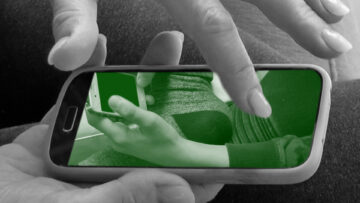
In her interactive video work SMART PANTHEON RGB, Myriam Thyes addresses the almost godlike devotion we give to our smart devices.
The work references Michelangelo's fresco "The Creation of Adam" in the Sistine Chapel, a depiction of the Genesis creation story in which both God and the first man, Adam, are depicted with their arms and hands stretched out towards each other. The work allows us to slip into the role of both, the hand of God and the hand of Adam. Through gentle zooming gestures we spiral through an endless loop of hands handling smartphones; a sensual work that focuses on the movement of the hands and makes us think about the relationship we have with our smartphones. In collaboration with Carsten Heisterkamp, the artist created a work based on her previous video work Smart Pantheon for this month’s HEK Net Works series that lets the audience dive deeper into their mobile devices.
The work could be accessed here and is best suited for iPhones and iPad devices: smartpantheon.thyes.com
HEK Net Works presented Myriam Thyes' work SMART PANTHEON RGB from 01.04.2022 to 30.04.2022.
Myriam Thyes is a Swiss and Luxembourg artist, currently living and working between Dusseldorf and Zurich. Her work evolves around social and cultural symbols and questions concerning their influence and change over time. Through her pictorial work with symbols, she aims to broaden perspectives and encourage exchange. Thyes studied at the Kunstakademie Dusseldorf and has exhibited internationally in various institutions and festivals as well as receiving numerous awards. She is represented by the imai Foundation, Dusseldorf, and videokunst.ch, Berne.
Dorota Gawęda & Eglė Kulbokaitė
Południca, 01.03.2022
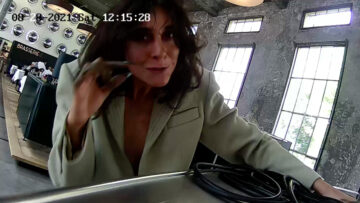
In the form of an animated video series by the artist duo Dorota Gawęda and Eglė Kulbokaitė, the Slavic demoness Południca wreaks havoc on HEK's social media account around noon.
According to a Slavic folklore, Południca, the so-called noon girl, appears to field workers in the countryside at the hottest time of the day and torments them with difficult questions. Those who are unable to answer the questions correctly suffer various punishments and torments ranging from curses to decapitation. During the month of March, Gawęda and Kulbokaitė will regularly post on HEK's Instagram account a series
of audiovisual edits of animations and video footage based on their newest performance work -lalia. Playing with the ambiguity of the mythological figure, and transposing it into a more modern context, the artists create a metaphor for contemporary anxieties in the face of ecological and social unease.
HEK Net Works presented Dorota Gawęda and Eglė Kulbokaitė's work Południca from 01.03.2022 to 31.03.2022.
Dorota Gawęda and Eglė Kulbokaitė have been working together as an artist duo based in Basel since 2013. Their interdisciplinary work rooted in feminism and fiction navigates between performance, installation, scent, sculpture, painting and video. The two artists from Poland and Lithuania are graduates of the Royal College of Art in London, UK. They have exhibited internationally including Centre d’Art de Genèva (2021), Kunstverein Leipzig (2021), Swiss Institute, New York (2020), Den Frie, Copenhagen (2020), MWW, Wroclaw (2020), Kunstverein Düsseldorf (2020), Palais de Tokyo, Paris (2018), 6th Athens Biennale (2018), MMOMA, Moscow (2018), ICA, London (2017), MOMA, Warsaw (2016), Berlin Biennale 9 (2016) and MaM, Paris (2015) among others. They have also participated in numerous international residencies at the Alserkal Arts Foundation, Dubai (UAE), La Becque, La Tour-de-Peilz (CH) and Onassis AiR, Athens (GR). Dorota Gawęda and Eglė Kulbokaitė are the winners of the Swiss Performance Art Award 2021 and the CERN Collide Residency 2022. They are also founding members of the Young Girl Reading Group (2013-
2021).
Dani Ploeger & Greenman Muleh Mbillo
Ûiiti, 01.02.2022
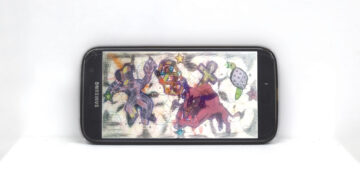
In their work Ûiiti (the treatment), Ploeger and Mbillo reverse the common functions of smartphones. The networking devices that let us switch irrevocably from one app to another, constantly demanding our attention with sounds, popping messages and vibration, become media of inner reflection, meditation and transcendence.
By creating a digital canvas that can be used to generate repetitive patterns of sound through touch, Ploeger and Mbillo put users in a contemplative state. While using the app, all other functions of the mobile phone are blocked so that one can fully engage in the experience. Ploeger and Mbillo thus expose and instrumentalise our everyday mobile phone focus and introduce us to a new use and contemplation of this constant companion. The symbolic forms of the design are inspired by a spiritual journey both artists had with a traditional healer of the Kenyan Akamba tribe. The intoning sounds come from field recordings of a ritual instrument that Ploeger and Mbillo made in Kenya. The app can be
downloaded from Google Playstore and can only be used with Android: play.google.com
The «Ûiiti» application puts the screen in pin mode, to exit pin mode perform the following three possible manipulations:
- Gesture navigation: Swipe up and hold.
- 2-button navigation: Touch and hold Back and Home.
- 3-button navigation: Touch and hold Back and Overview.
HEK Net Works presented Dani Ploeger and Greenman Muleh Mbillo's work Ûiiti from 01.02.2022 to 28.02.2022.
Greenman Muleh Mbillo is a Nairobi-based thinker, farmer, artist and philosopher of the ancient Akamba system and traditions. He studied mechanical engineering, but mainly developed his current areas of interest through study in non-institutional contexts, including the practice of doctor and priestess Kanukwa.
Dani Ploeger is a media and conceptual artist and cultural theorist. After growing up in the Dutch countryside, he eventually obtained a PhD in media studies and performance from the University of Sussex, UK. He is currently a Research Fellow at The Royal Central School of Speech and Drama, University of London and a Fellow at V2_Lab for the unstable media in Rotterdam. His artwork is represented by Art Claims Impulse in Berlin.
Since 2016, Dani and Greenman have collaborated on various artistic research projects in Kenya, as part of www.disobedientdevices.org. Their work has been exhibited at the Nairobi National Museum, Alliance Française Nairobi and the British Institute in Eastern Africa, among others. For more information about the background of the work, please see this text by Greenman and Dani: www.disobedientdevices.org/tech-of-transcendence
Katrin Niedermeier
Somehow Clothing, 07.12.2021
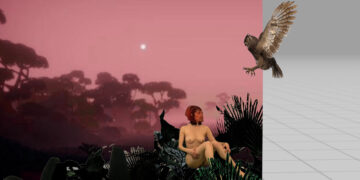
In her work, Katrin Niedermeier reflects on the oscillating connections between the virtual space and the real world, while investigating the influence that technologies and the digital economy have on the human condition. Her recent work Somehow Clothing intertwines the virtual world of avatars and the trade of digital artefacts with performances, videos and the creation of real clothing.
Niedermeier copied digital products for sale online, such as female avatars and their fictitious accessories and environments, as well as the promotional and advertising elements on the websites selling these products, such as slogans and license agreements. From these elements, the artist has produced a limited series of clothes, sweaters and scarves. These garments are thus a translation of digital information into knitted analogue material, each garment specifically representing idle poses on the avatar sales websites. This work refers mainly to stereotypes relating to the representation of women's bodies and their functions in virtual universes. At a later stage, these sweaters are interpreted by professional dancer Zina Vaessen, who then interprets the poses of the virtual avatars, transposed into the garments, in a contemporary dance. The videos of the dances are published on HEK's social networks, somehow closing - or rather multiplying - the loop connecting the virtual and the real. Through these multi-layered actions of translation, feedback and reintroduction into new media, these avatars can be reactivated by the public who can buy the clothes and wear them in turn. The garments are on sale on the artist's website:
https://katrinniedermeier.com/...
HEK Net Works presented Katrin Niedermeier's work Somehow Clothing from 07.12.2021 to 10.01.2022.
Katrin Niedermeier (b. 1978 in Munich, DE) accomplished her master’s degree in 2019 at the Institut Kunst HGK, FHNW in Basel. She previously studied fashion design in Munich and Oslo and worked as a designer for Christian Dior and Jeanne Lanvin in Paris, and Nicky Hilton in Los Angeles. Recent exhibitions and video screenings include: To Be Human at Zona Mista, London (2021), Phenomenal Ocean at Ocean Space, Venice (2019), ihood at Kunsthaus Baselland, Muttenz (2019), color your color at EMAP Ewha Media Art Presentation, Seoul (2019), Hidden Bar, Art Basel (2019) and the group exhibitions Digital Festival DA-Z, Zürich (2020), and Hyperconscience at Shadok, Strasbourg (2018).
Ed Fornieles
Associations 12#, 08.06.2021
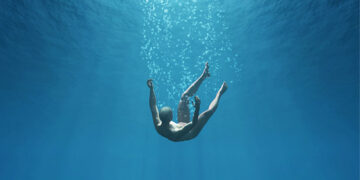
Ed Fornieles’ recent project Associations is a personal look at the cultural environment we inhabit. The artist has collected pictures from the internet, ordering them in series of images through an associative process based on similarities in form and content: from the image of a hand to that of a family leading to a house and finally to the globe of the world.
Elsewhere the association of a couple holding hands leads to a passionate kiss, the globe to a dinosaur and the open palm of a hand to the superhero Tony Stark interpreted by Robert Downey Jr. Through creating chains of associations Fornieles maps out his own predilections, tastes and biases as well as the boundaries of a wider space of cultural possibilities. As in his previous works, the artist exemplifies here his ongoing investigation with how identity is formed, replicated and sustained through the ongoing myriad of pressures that make up daily life. Ed Fornieles’ Associations 12# was featured on the Instagram feed of HEK from 08.06. till 07.07.2021.
Ed Fornieles is an artist working in London. He has exhibited at The Serpentine Gallery, Chisenhale Gallery, Martin Gropius Bau, amongst various other institutions and galleries.
Martina Menegon
It feels like home, 11.05.2021
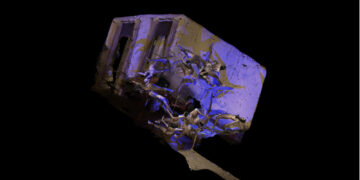
In It feels like home, Martina Menegon negotiates perception and forms of her own body. Menegon's roughly 3D-scanned bedroom is presented in orthogonal view and cyclically fills with extremely low-poly 3D-scanned virtual clones of herself, each in perspective view.
This very personal and intimate space is now accessible online to everyone, and its inhabitants, despite their virtual nature, become perceptible when the user's cursor touches and interacts with them. Every hour or page refresh, the gravity of the virtual room can change randomly, causing a shift in the perception of the space. Sound by Alexander Martinz. The work was visible here from 11.05. to 08.06.2021.
Statement by the artist:
“It feels like home is an
online intervention that uses the synthetic space of the browser as a
stage to unfold an interactive, performative and generative virtual
sculpture. Experimenting with the notion of digital sculpture, It feels like home
reflects on the site-specificity within the virtual as well as the
offline spaces, while it goes through hourly and algorithmic
transformations, becoming a performative process that continuously
produces unexpected and unpredictable results that depends on each
visitor’s offline time-zone. Especially after more than one year of
pandemic, locked inside and constantly online, the notions of time, home
and personal space feel in constant change and contradiction,
helplessly transient.”
Martina Menegon is an artist working with interactive and augmented reality. In her work, Menegon creates intimate and complex assemblages of physical and virtual elements that explore the contemporary self and its synthetic physicality. She experiments with the uncanny and grotesque, the self and the body, and the dialogue between physical and virtual reality to create disorienting experiences that become perceptual despite their virtual nature. During the lockdown, she has created several works, for example for the virtual platform Mozilla Hubs, where she continues to develop her research on Virtual Reality and 3D images.
She (*1988) currently lives and works in Vienna, Austria. She is a University Assistant and Lecturer at the department of Transmedia Art at the University of Applied Arts in Vienna, where she teaches “Digital Design and Virtuality”. She is also teaching multimedia tools for interactive arts at the IUAV University in Venice (MA Digital Exhibit, BA Multimedia Arts) together with Klaus Obermaier and Stefano D’Alessio. She is currently Head of Extended Reality and Curator at the “Area for Virtual Art” a platform for immersive experiences and get-togethers founded by sound:frame and Pausanio. She is also part of the curatorial team of the new media art festival of Vienna CIVA Festival.
Dirk Koy: Raum, 13.04.2021
Raum, 13.04.2021
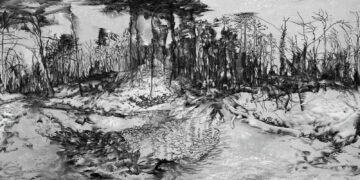
Dirk Koy creates surprising audio-visual works in which the viewer's perception is often challenged. His work Raum is a moving, 360°, digital and analogue drawing, created during the lockdown. During this time in which movement options were severely limited, nearby natural space, digital space, and one's imagination offered the opportunity to leave home to experience other places.
In this work, a space is created that leads users to the intersection
between reality and virtuality. Sound and movement create an immersive
experience in an environment that feels moving and organic, but in its
form can only exist in digital space. Raum could be experienced online on HEK's Vimeo page as well as on our social media from 13.04.2021 to 11.05.2021.
Statement by the artist: "Pencil drawing, photography, digital texture and movement merge into one big whole. Everything seems to be set in motion. The viewer becomes part of the action and decides which point of view he/she wants to take. The individual media layers begin to correspond with each other and allow the viewer to dive into an uncontrolled, porous world. Below and above dissolve, individual image layers break open, seemingly subterranean things come to the surface: unpredictable, erratic, with long pauses, then continuous again. The familiar becomes strange, the strange becomes familiar."
Dirk Koy is a Swiss artist and lecturer at HGK FHNW Basel for time-based media. Originally trained as a graphic designer, Koy works primarily with audio-visual media. In his award-winning works, he experiments with everyday images and environments, using both analogue and digital techniques.
Ted Davis
GLITCH.ext, 09.03.2021

Ted Davis' GLITCH.ext enables visitors to glitch HEK's virtual façade and the website hek.ch. Images, texts, and every HTML element forming the website's structure could be glitched by the visitor with the click of a mouse. If one continued to move the mouse over the chosen element, it is possible to influence the outcome of the glitch. Building on the artist's recent p5.glitch (2020) – a byte-level glitching library within p5.js – a companion browser extension for Chrome also allows users to keep glitching the rest of the web. GLITCH.ext was visible from 09.03.2021 to 13.04.2021 on thewebsite hek.ch.
The Chrome extension GLITCH.ext can be installed from the Web Store or manually from GitHub.
Statement by the artist:
"As culture transitioned from physical to virtual during the past Covid-19 year, GLITCH.ext pays homage to glitch in both the analogue and digital domain: Firstly, to HEK's own glitch façade, H3333333K (2015) by !Mediengruppe Bitnik, an architecturally implemented JPEG-glitch. Secondly, glitching websites incites Glitch Browser
(2005) by Dimitre Lima (DMTR), Ant Scott (BEFLIX) and Iman Moradi,
which JPEG-glitched all images of a given website via proxy server.
During my master studies here in Basel (2007-2009), resulting in a
thesis focused on glitching the JPEG file format, Precise Mishandling of
the Digital Image Structure, virtual exchange with the artists behind
Glitch Browser and local video-sniffing workshops by !Mediengruppe
Bitnik helped shape my developing practice. They joined a growing
exposure to notions of revealing the invisible, exploiting digital media
below the surface, and networked art. Starting with TEXT2IMAGE and HEADer_REMIX (2009),
throughout the past 10+ years, glitch continues to find its way into my
work, with its endless stream of surprising images and unique artefacts
to discover."
Ted Davis is a media artist, designer and educator originally from the United States and based in Basel, Switzerland. Since 2010 he teaches interaction design within the Visual Communication Institute at the Basel School of Design HGK FHNW. His work and teachings explore the volatility of digital media through glitch and reactivating older ‘new media’ through newer programming means. His open-source projects (basil.js, XYscope, P5LIVE) enable designers to program within Adobe InDesign, render vector graphics on vector displays, and collaboratively create live coded visuals.
Rosa Menkman
The BLOB of Im/Possible Images, 09.02.2021
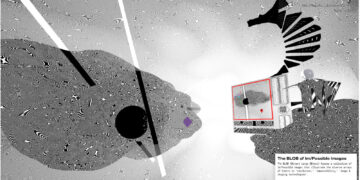
The BLOB of Im/Possible Images by Rosa Menkman features some special and liminal images that the artist collected from her ongoing research. During her Art@CERN residency, Menkman researched impossible images, by asking scientists to imagine 'impossible' images of any object or phenomenon that they think are important. As a result of this exploration, Menkman created a low poly rendition of the unquantifiable blob of possible and impossible images that are very hard or simply impossible to resolve, due to constraints in the affordances of our image processing technologies.
Some of these images may have otherwise never found the way to our eyes, they may remain impossible or only exist in the hypothetical nooks of the BLOB, that functions as an archive of Im/Possible images. The work also comes with an open call for impossible images: with a form accessible from inside the BLOB, Menkman invites new submission to the archive. The BLOB of Im/Possible Images was visible from 09.02.2021 to 09.02.2021: newart.city/show/menkman-blob-of-im-possibilities
Rosa Menkman engages with the outcome of accidents in digital and analogue media. Her work takes common visual elements of digital images, such as glitches, distortions and colour errors, which are reframed and staged in various formats, including installations, video works, and online projects. The video work The Collapse of PAL (2010) uses various glitches along with audio track as narrative devices to tell the story of the now obsolete PAL signal. The artist also deals with the history of the processing and archiving of digital image data in various works such as DCT:SYPHONING (2015-2017). Under the title Glitch Moment(um) she published a book in 2011 that discusses the aesthetic and cultural relevance of glitch art, and established it as a genre.
Statement by the artist:
"My work focuses on noise artifacts that
result from accidents in both analogue and digital media (such as
glitch and encoding and feedback artifacts). I think the resulting
artifacts of these accidents can facilitate an important insight into
the otherwise obscure alchemy of standardization via resolutions. The
standardization of resolutions is a process that generally imposes
efficiency, order and functionality on our technologies. It does not
just involve the creation of protocols and solutions, but also entails
the obfuscation of compromises and the black-boxing of alternative
possibilities, which are as a result in danger of staying forever unseen
or even forgotten. Through this research, which is both practice based
and theoretical, I try to uncover these anti-utopic, lost and unseen or
simply 'too good to be implemented' resolutions, to find new ways to
understand, use and perceive through and with our technologies."
Marc Lee
Bobi Wine vs Museveni, 12.01.2021

Conceived for the HEK Net Works series, the work Bobi Wine vs Museveni is a variation of Marc Lee’s former work Political Campaigns. What counts today are Likes and Retweets, who wanders across the screen as stars (Museveni) and hearts (Wine), fighting for victory. Whatever the end of the presidential election, it will be historic. Bobi Wine vs Museveni was visible from 12.01.2021 to 09.02.2021 here with these settings.
The online work Bobi Wine vs Museveni filters out the latest Twitter and YouTube messages containing the terms "Bobi Wine" and "Yoweri Museveni" and weaves them into a wild TV news programme (24/7). A net-based TV show that confronts us with opinions that do not always reflect variants of our own opinion. Robert Kyagulanyi Ssentamu, better known under his stage name Bobi Wine is a star for the youth in Uganda. He raps, does politics and, as the most promising presidential candidate, is a threat to Uganda's long-term president Yoweri Museveni. The election took place on 14 January 2021. Bobi Wine grew up in the digital revolution, has access to political activist strategies and creative expression. He uses the internet as a virtual public space where his followers come together, share their lives and ideas, open to comment and debate. There are several Ugandans within Uganda. With platforms like Twitter and YouTube we can take a look at what the real Uganda looks like and what it thinks. What do people in Uganda really say? What ideas do they project? What kind of discourse is taking place on these platforms around the presidential elections? Can the interplay of artistic and political activist strategies lead to democracy in Uganda? What does this mean for the future of the country?
The Swiss artist Marc Lee creates network-oriented interactive art works. In his projects he experiments with the data and methods of information and communication technologies to critically examine their cultural, social and political ramifications.
Gysin & Vanetti
24 times, 08.12.2020
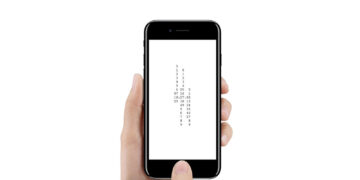
The work 24 times, created for the HEK Net Works series, is part of the Clock series and consists of 24 variations around the clock theme. Each of these 24 clocks displays the time of day in real-time, but with different and unusual formats. The results are rhythmic compositions of numbers, letters, and signs, such as the sum of all the numbers that make up the hours, minutes, and seconds of a given moment, or the appearance of a cuckoo every half hour.
24 times (from the Clock series) was visible from 08.12.2020 to 12.01.2021 here: https://24times.gysin-vanetti.com
Tip: open the site on your mobile phone, choose one of the 24 clocks, and add it to your Home screen to get your personalised watch!
Set in a tradition that ranges from concrete art to kinetic and programmatic art, the artists Andreas Gysin and Sidi Vanetti develop projects that often make use of recuperated mechanical systems. The work Zürich HB Flap (2016) is a spectacular example of this. Gysin & Vanetti obtained the monumental mechanical signage panel of Zurich's main station comprising 452 split-flaps elements – and replaced in 2015 by a digital panel – to reprogram it in order to create a kinetic installation. Their transformations, which the artists call 'found geometries', often take on a playful and sometimes absurd character. For example, they created a video mapping projection for the façade of a baroque church in Locarno (S.Antonio, 2007), choreographed a series of moving headlights (Fari, 2014-16), or programmed a sand drawing machine to produce geometric compositions (Sabbia, 2017).
IOCOSE
Moving Tasks Forward, 10.11.2020

The work Moving Tasks Forward, realized by the Italian artist group IOCOSE for the HEK Net Works series, is one of a series of works that focus on the idea of moving the world forward, often ironically playing with the double meaning of the concept of moving forward. Moving Tasks Forward was available from 10.11 to 8.12.2020 here for the web-based Trello application.
Founded in 2006 by four artists (Matteo Cremonesi, Filippo Cuttica, Davide Prati, Paolo Ruffino), IOCOSE investigates how the narratives surrounding the future of society and technology leave traces on the present. Using a variety of media, they take a special look at media culture and digital communities. They have created fictions that critically comment on existing phenomena, such as videogame-induced pathologies (Game Arthritis, 2011), the collective creation of conspiracy theories (A Crowded Apocalypse, 2012) or online services to sell personalised protests (Instant Protest, 2017).
Statement by the artists:
"Moving Tasks Forward is a
script that can solve the long list of tasks that flood our daily to do
lists. Online to do lists are a common tool to organize any kind of
work activity in a given time frame. Usually, a list with the name ’To
Do’ containing tasks still to be done is placed on the left side of the
screen. When the user completes a task, they move it forward, on the
right side of the screen, usually under a reassuringly named column such
as ’Done’, ’Erledigt’, ’Fatto’. The Moving Tasks Forward
script automates and streamlines this process. Once launched in the
browser, the script moves the tasks forward automatically at regular
intervals, whether they have actually been done or not. The result is a
twofold positive effect: the drastic reduction in stress generated by
unfinished tasks, coupled with a priceless sense of satisfaction at
having done our part, helping to move the whole world forward, one task
at a time. With Moving Tasks Forward IOCOSE continue undaunted the movement of the world forward, one object at a time.”
Michael Mandiberg
Virtual Background, 13.10.2020

During the lockdown, American artist Michael Mandiberg painted the background of his call partners during video calls and translated this virtual scenery into something haptic. For the HEK Net Works series, Mandiberg provided some of these images as virtual backgrounds that could be downloaded to your own computer. The Virtual Backgrounds from Mandiberg could be downloaded from 13.10. to 10.11.2020 and used as a virtual background for online video calls.
Michael Mandiberg is an interdisciplinary artist who reflects on the socio-political dimensions of information technology, while exploring its poetic expressions. For example he has developed a software that converts all prices on any webpage into their equivalent value in barrels of oil, and thus drew attention to an ongoing ecological crisis (Oil Standard, 2005). He was the co-founder of the Art+Feminism (2013-ongoing) initiative, which aims to promote the presence of women in the online encyclopaedia Wikipedia. Mandiberg also wrote software that transforms the entire online encyclopedia into 7,473 volumes of 700 pages between 2009 and 2016, underlining the incongruity of such an operation (Print Wikipedia, 2009-16). His recent work, Postmodern Times (2016–18), consists of short films commissioned to the online crowdsourcing platform Fiverr.com, for the creation of a film that takes up the theme of Charlie Chaplin's famous film, Modern Times, to propose a current portrait of work in the digital age. Lately, Mandiberg painted the background of the friends they had video calls with during the lockdown.
Statement by the artist:
"As New York paused for COVID-19, my
human contact and communication ceased. Like many information workers, I
found myself on hours of daily video calls. A rotation of familiar
faces, sitting across from me in unfamiliar rooms punctuated my
work-day. I’ve visited makeshift office spaces, the kitchens of
co-workers, and the childhood bedrooms of my students, observing the
ways in which people choose to frame their environment for a call, or
completely neglect to. In response, I have begun a series of paintings
that capture and collect these interactions. Each painting corresponds
to one of the video calls I have made while in quarantine, and depicts
the room of the person on my call. Sized at 6” x 11” each painting
reflecting the Zoom call’s 9:16 proportions. If possible, I have tried
to complete each painting in the time-span of the video call from which
it was sourced. Still, when the demands of my call keep me from
painting, I let myself complete the paintings after the fact. I paint
these rooms without the person sitting before the camera. In doing so,
this series serves as a record of interactions marked by absence. An
absence mediated low quality lenses, compression algorithms, and choppy
connections that skew off-white colors into light-pinks, yellows, and
cool blues. This painting practice has helped me cope with the cognitive
exhaustion from all the video calls, and the anxiety of self-isolation
while the sirens howled through the streets around me. I know that
isolation is a privilege, but for me it is a necessary one, as I am
immunocompromised. Painting these canvasses has been an attempt to log
memory, as much as it is also a practice of self-care and preservation.
Time has shifted in the absence of regular routine, and I have lost
track of what day it is. These paintings help me keep track of digital
experiences that are more likely to slip away and be forgotten. They are
memory, and memorials.”
Ann Hirsch
What A Cutie, 08.09.2020

What A Cutie is a video the artist's iPhone created from a collection of photos and videos the Los Angeles based artist Ann Hirsch took of her four month old daughter, Elisheva. This gesture examines technological automation in a time of public social identity. More specifically, how large media corporations such as Apple or Facebook, steal our information but soften the blow by giving us little presents like targeted ads, email word suggestions, or pre made videos we can share with friends.
Statement of the artist:
"And anyways, we thought the iPhone did a wonderful job of
grabbing the best content and putting it together in a way that really
celebrates the artist's daughter and makes our hearts swell. This video
is probably as good, if not better, than what Hirsch would make herself.
We're so often consumed with “surveillance,” “the blockchains,” and “online visibility” that sometimes we may not have time to appreciate the beauty of little babies. Now admittedly, we have some guilt over sharing this video (even though the artist insisted) because we think about Jeff Bezos and the Zuckerbergs and we wonder if they are going to steal these images of this poor baby and sell it to baby companies? Or to the government? Track her for the rest of her life? But then we decided not to dwell on that because the priority is having people see the artist’s baby. Also, we're only going to keep this video up for a month or so and then it'll be down so we won't be exposing Elisheva TOO much you know.
It's funny, ultimately, this art work has made us think! What is more important, for people to see the artist's baby or for people to see her art? Hmmm, we are not sure. Artist's egos are so fragile, often their sense of self worth gets caught up in their "babies;" whether that be their artworks or their actual children. It's a bit sad really that they can't separate themselves from them, but as an art institution, our job is to reinforce the artist's sense of self and let them know "You are important!"
Anyways look at this goddamn baby and tell me you're not obsessed!!! She’s special!!!!"
In her works Ann Hirsch looks at how identity is performed within popular culture and the web. She often investigates cultural shame and how it is applied to gender.
Molly Soda
Cutting My Bangs At Home!, 11.08.2020
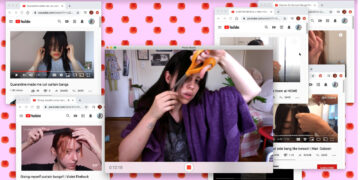
Molly Soda (alas Amalia Soto), a Puerto Rican artist currently living and working in New York, has become an internet celebrity thanks to her appearances on social media platforms. For the HEK Net Works series, she created the work Cutting My Bangs At Home!, an ironic reference to popular Internet phenomena. Cutting My Bangs At Home! was visible from 11.8 to 8.9.2020: https://vimeo.com/446837667
As an artist, she questions the process of building personal identities and their reception, playfully deconstructing the representation of women in popular culture. Her work includes the first Tween Dreams, a humorous series for teenagers in which she played each character; Me and My Bear, in which she documents her engagements with a six-foot teddy bear; and Should I Send This? a reading performance of all the messages from her Tumblr account. In 2017, she co-edited with Arvida Byström the book Pics or It Didn't Happen: Images Banned From Instagram. She has been called a cultural social media anthropologist and her work has been presented in museums and galleries around the world.
Statement by the artist: "In this video I attempt to follow various YouTube hair cutting tutorials, specifically for a style of bangs referred to as ‘curtain bangs.’ Many of these videos have been uploaded in the recent months of lockdown as most people haven't had access to a hairdresser and have a lot more time on their hands. The video acts as a personal archive as well as a time capsule of this very specific moment in time through an at-home haircut. The webcam acts as the mirror for me to cut my hair."
Joana Moll
Ultimate solvers, 07.07.2020

Ultimate solvers, Joana Moll’s contribution to the HEK Net Works series, reveals the techno-utopic philosophy of international design companies through their cynical slogans. Ultimate solvers was visible from 7.7 to 14.7.2020: www.janavirgin.com/HEK/
Joana Moll is an artist who lives and works in Barcelona and Berlin. Her work analyses the repercussions of techno-capitalism on social dynamics and the very development of digital technologies. Topics such as surveillance, the lucrative exploitation of personal data and the ecological impact of digital technologies are recurrent in her work. She has created net-based installations that display in real time the CO2 production generated by the global search of google users. She has also exposed current practices of online dating sites and their dubious use of private data.
Statement by the artist:
"COVID-19 crisis has exposed a massive
social, ecological, political, and economic systemic failure. Even
though the causes and consequences of this crisis are highly complex and
profound, we’ve been repeatedly told that it can be solved with yet
another app. This technical problem-solving approach is commonly known
as techno-solutionism. Techno-solutionism tends to simplify and
obfuscate the several realities that trigger the particular problems
that it’s trying to fix; it simply doesn’t cope with problems. Even
though it’s been demonstrated that techno-solutionism doesn’t work when
it comes to fixing highly complex events, such as the current global
pandemic, it is once again enthusiastically embraced as the only
possible answer to a critical situation. But who is defining and
implementing these technological fixes? Ultimate solvers
collect a series of slogans, brand identities, and supporting graphic
materials used by the main corporations that prescribe technological
fixes to announce their products. Interestingly, these companies tend to
use quite a precise language to define what they actually do in a very
unprecise way. Nevertheless, these corporations do understand,
precisely, how to benefit from the realities that their technologies
will create and extract from. One can’t help but wonder what will be the
long term implications of solving highly complex systemic problems with
reductionist techno-solutions. The future doesn’t look bright."
exonemo
Realm, 02.06.2020
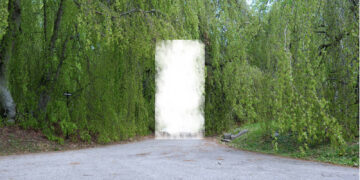
The new work Realm by the Japanese artist duo exonemo invites users to explore a website which is displayed differently depending on whether the user runs the desktop or mobile version of the browser – allowing either touch or vision. Realm was visible from 26.5 to 2.6.2020 here: exonemo.com/realm/
exonemo was formed in 1996 and consists of Sembo Kensuke and Akaiwa Yae. They explore digital technologies in a playful and entertaining way and have created online works since the early years of the World Wide Web. More particularly, their work investigates the inconsistencies between analogue and digital tools and between physical and virtual reality. They also organize collective events, such as the Internet Yami-Ichi, a fleamarket of net-based things.
Statement by the artists: "We know that we are in between here and there, the natural and the man-made, or the future and the past. And will always see a realm there. Someone is advertising that it could be touched, but no one has ever touched it and no one knows about that."
Fatih Holland
Touchscreen, 19.05.2020
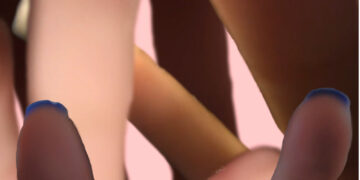
For the HEK Net Works series, New York-based American artist Faith Holland had created a new GIF, which focused on the theme of distance due to isolation and the desire, or frustration, of the sense of touch that is replaced by virtual online encounters. The GIF was visible from 19.5 to 26.5.2020 here: http://faithholland.com/touch/touch.html
Holland’s work focuses on deconstructing images of sexual bodies in popular culture. In particular, Holland practices a feminist re-appropriation of pornographic imagery through a fetishization of technology as a performative and subversive act. Her work includes performances, videos, installations, and thematic websites. GIFs are an important part of her work, of which the Visual Orgasms series is exemplary. These are a colourful and joyful metaphorical visualization of orgasms in multiple forms, such as abundance of waterfalls and fireworks.
Statement by the artist:
"In Touchscreen, different
hands reach out to touch the camera. It appears that they rub up against
the screen itself, but they are simulating touching you. With these
caresses, the viewer and the screen are collapsed; we are asked to
identify with a flat, unfeeling piece of glass. In this new environment
where touch has become dangerous, we accept this simulation more
willingly, just like the simulations of parties, meetings, and classes."
Lauren Huret
Kimey’s feed, 12.05.2020
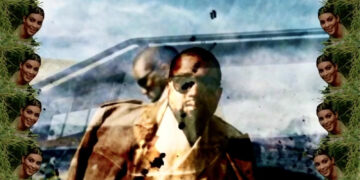
For the HEK Net Works series, the Geneva based artist Lauren Huret produce stories on Instagram for one week, directly drawing and re-using content posted by celebrities – in particular the Kardashian-West-Jenner family – who have an impressive number of followers and therefore accompany and define the daily lives of millions of people.
Huret's work examines systems of belief produced by the media, particularly social networks, over our habits and behaviours. The artist intelligently uses available technological tools. She overlays images and videos with graphic elements such as smileys, icons and texts.
Statement by the artist:
"For years, I have been fascinated by
the complete creation of public, staged self-fiction, and the private
sphere of celebrities, through the use of new technologies and social
networks. This total iconic production, highly mediatised, is for me
completely embodied in the figure of the Kardashian-West-Jenner. They
produce a new economy and new media rituals, and they generate a common
imaginary that seems both near and far thanks to social networks (and
convey sometimes problematic values). This week, by investing the HEK Instagram
account, I decided to post stories prepared, tinkered with, recomposed,
and made entirely from the material posted on Instagram by the
Kardashian-West-Jenner. Like painters depicting a landscape before their
eyes, I will compose these shots using only image editing applications
installed on my phone and tools set up by social networks to make
images. A sort of research journal, the stories created this week may be
an opportunity to rethink the worship, influence and imagery developed
by stars as new religious and political icons."
:: vtl :: aka Dimitry Morozov
Under pressure, 05.05.2020
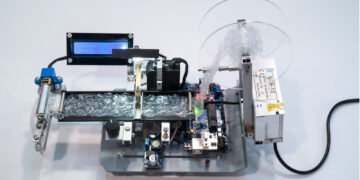
For the HEK Net Works series Russian artist ::vtol:: aka Dmitry Morozov created a small machine that automatically breaks the bubbles of a bubble wrap foil so that the audience can enjoy the process and relaxation of this entertaining process during the lockdown period. The installation was running and visible via live stream from 5.5. to 12.5.2020 here: vtol.cc/filter/works/under-pressure
Morozov is a transdisciplinary artist and researcher. He focuses on contemporary media arts including sound, robotics and installation, placing special emphasis on the link between emergent systems and new kinds of technological synthesis. He has built many robotic installations, which touch on themes such as ecology, the information society and interpersonal relations.
Statement by the artist:
"In these turbulent times, everyone
really lacks the usual rituals and actions that allow for a certain
balance. One of many people's favourite pastimes is popping the
bubble-wrap. 'Under pressure' is a mechanism that does this
automatically: a useless machine whose only function is to blow bubbles
in the film. The machine is installed in my workshop and through the
broadcast on YouTube, anyone can watch it, destroying their stress. The
idea for this machine came many years ago and at first, I conceived it
as a very large-scale one. The circumstances gave a different result: on
the one hand, it proved important and urgent to carry out this work at
this time; on the other hand, the machine had to be produced in small
dimensions and with random materials found in my workshop."
Jonas Lund
I just stare at my computer waiting for something to happen, 28.04.2020
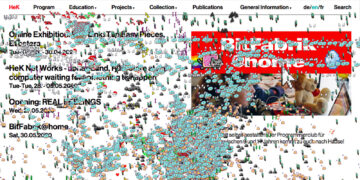
Intervening on the website of HEK, Swedish artist Jonas Lund produced a script for a period of seven days that reveals the presence of other users in real time. Each movement with the cursor left traces of this movements on the screen, in the form of graphics generated by an online community, reminiscent of the aesthetics of the nineties. Every website visitor could try out the digital work exclusively from 28.04. to 05.05.2020 at www.hek.ch.
Lund experiments with different formats of art production and distribution, playfully questioning the existing models related to the commercialization of art. In particular, he explored the emergence of new habits in the art world with the appearance of new digital tools. For example, he conceived the exhibition Critical Mass (2017) that evolves and changes over time, depending on an online survey that enables users to select their preferences regarding the exhibition design. He has also created 100,000 shares in the form of crypto currency tokens, allowing shareholders to have a say in his artistic career and future practice.
Statement by the artist:
"Since HEK first invited me to do
something on their website two weeks ago, I've been mulling it over,
finding it surprisingly difficult to find the right angle or approach.
Everything is at the moment naturally surrounding Covid-19, so making
work about anything else feels not too relevant, yet making work
specifically about Covid-19 feels like it's too early, too much. Most of
the days of the lockdown I just stare at my computer waiting for
something to happen. For people who are used to working at home, it
shouldn't be a big difference, but it feels completely different. I
wonder if more people feel this way, if we are all connected through
this moment, what if I could see you move when I move? Synchronised
serendipitous movements across space. In I just stare at my computer
waiting for something to happen every users trail is synchronised with
all the visitors to the website and you see everyone's cursor trail. The
cursor is chosen at random from the complete archive of cursors from
the RealWorld Graphics website,
and is unique to one person. Revealing the loneliness and the
togetherness at the same time through a serendipitous meeting at the HEK
website."
Addie Wagenknecht
The perfect cat eye with your zoom date, 21.04.2020
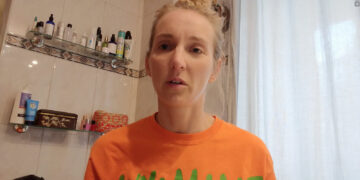
In her new video The perfect cat eye with or without your Zoom date for the HEK Net Works series, American artist Addie Wagenknecht (*1981) takes over the popular makeup tutorial format, common on media channels like YouTube, to instruct the viewer on her beauty routine. However, as she proceeds to apply mascara and lipstick to her face, she takes advantage of this opportunity to talk about security gaps in video communication platforms like Zoom – especially when used for intimate and erotic exchanges – and to propose alternative solutions.
Especially in this time of lockdown, when digital interaction has replaced live contact, new forms of communication are once again raising privacy issues. Exploiting the format of beauty video tutorials, Wagenknecht talks about digital privacy and data security policies, involved in platforms such as Zoom or Whatsapp.
In her artistic practice, Addie Wagenknecht deals with questions related to net culture and cyber security. Liminal Laws, her first solo exhibition in Switzerland presented at HEK in 2016, examined the effects of media technology on society, while also addressing the unequal distribution of access to information among the population. She lives and works in Innsbruck, Austria.
Keiken
Ozone, 14.04.2020
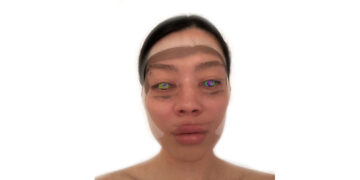
For the HEK Net Works series, the art collective Keiken has released Ozone, a new filter and series of short performative videos, posts, stories and live stream on HEK’s Instagram. Ozone introduces a new fictional and tongue-in-cheek digital spiritual practice called ‘Ozone Layering’ formed during the lockdown. Users must practice still or slow movements whilst their environment moves around them. The filter maps the environment onto the users’ faces, creating a personal connection. With this new work, Keiken plays on trends, rituals and language used on Instagram and in social media.
Ozone layering method.
Step 1:
Go on Instagram and find a filter (for best effect please use ‘Ozone by Keiken’, this is available on both @hek_basel and @_keiken_ .
Step 2:
Once you have found the filter, take three deep breaths and then press
record. Film yourself standing still or with slow movements with the
filter on (this can either be a short 15 second session or a longer one,
I like to go no longer than a 5 minute livestream).
Step 3:
Post the Ozone Layering session either through stories or posts, don’t
forget to post a caption to spread the Ozone Layering spiritual message
and gain more followers.
Step 4:
Once lockdown is over, we will practice faster movements, the speed of
these movements will be organic and dependant on whether capitalism
resumes its normal speed or whether other forces will change this
rhythm.
Joan Heemskerk (JODI)
GOL and NBKM, 07.04.2020
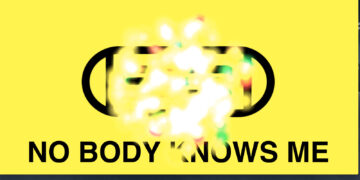
Joan Heemskerk, part of the net pioneer collective JODI realized two works for the HEK Net Works series: GOL
and NBKM. The URLs http://x20xx.com/nbkm and http://x20xx.com/gol are graphically visual settings in the unmistakable style of JODI, both of which allude to the threat of the corona virus.
GOL (Game of Life) and NBKM
(no body knows me) are part of the overarching work complex x20xx (http://x20xx.com/),
a series of visual scenarios relating to personal, scientific or news
events, which are expanded and continued at loose intervals.
JODI (JoanHeemskerk and DirkPaesmans) were among the pioneers of Net.art in the mid-1990s. From the very beginning, they have investigated and subversively undermined the conventions, structure and protocols of the Internet in their works. They work with computer programs, computer games and video and actively intervene in the language and code of these systems. With their radical disruptions, they draw attention to the mechanisms of these systems and our use and relationships with them.
Maria Guta
Day of my Life, 31.03.2020
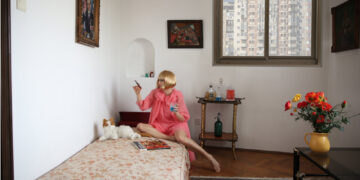
Artist Maria Guta was stranded in Bucharest, Romania (her country of birth) during the first lockdown of the Covid 19 pandemic and was unable to travel back to Switzerland, where she lives in Neuchatel, for months. For the HEK Net Works series, she realized a video that shows her in the apartment in Bucharest, staging herself as a bored housewife. With the ironic refraction of her situation, Guta addressed on the one hand her experiences of growing up in the so-called Eastern Bloc, as well as the current situation of social distancing and isolation during the pandemic.
Statement by the artist: «In an age where the idea of a totalitarian, restrictive regime is mostly a somber reminder of a pre-1989 era (or material for dystopian scenarios) it’s interesting to observe how the world – starting with some of the most democratic countries – is suspending «voluntarily a couple of the most basic human rights and freedoms by imposing the first nationwide lockdowns since World War II. And, although the causes are of a very different nature today, I can’t stop myself from drawing a line between the current restrictions and those experienced by prior generations (me included, as a kid growing up in Romania in the late 80s) under totalitarian regimes.
During Ceausescu’s dictatorship but also a while after (through the harsh transitional period that followed the “89 revolution), the greatest form of escapism were Hollywood movies (in communism only available through the VHS black market). Because of my then early age and a certain naivety, I initially became fascinated with American „cheap” cinema, soap operas and later on Latin-American telenovelas, where everyday life was blending in a fantasy world and reality was basically represented as illusion. This fictional form of escapism was very “first-degree” rewarding for eyes and senses, and most comforting in times of discomfort. That’s also when I started impersonating different characters, which is a big part of my practice today.
All the best from Bucharest!»
Read the whole text on Vimeo
https://bit.ly/3dGU0Hu